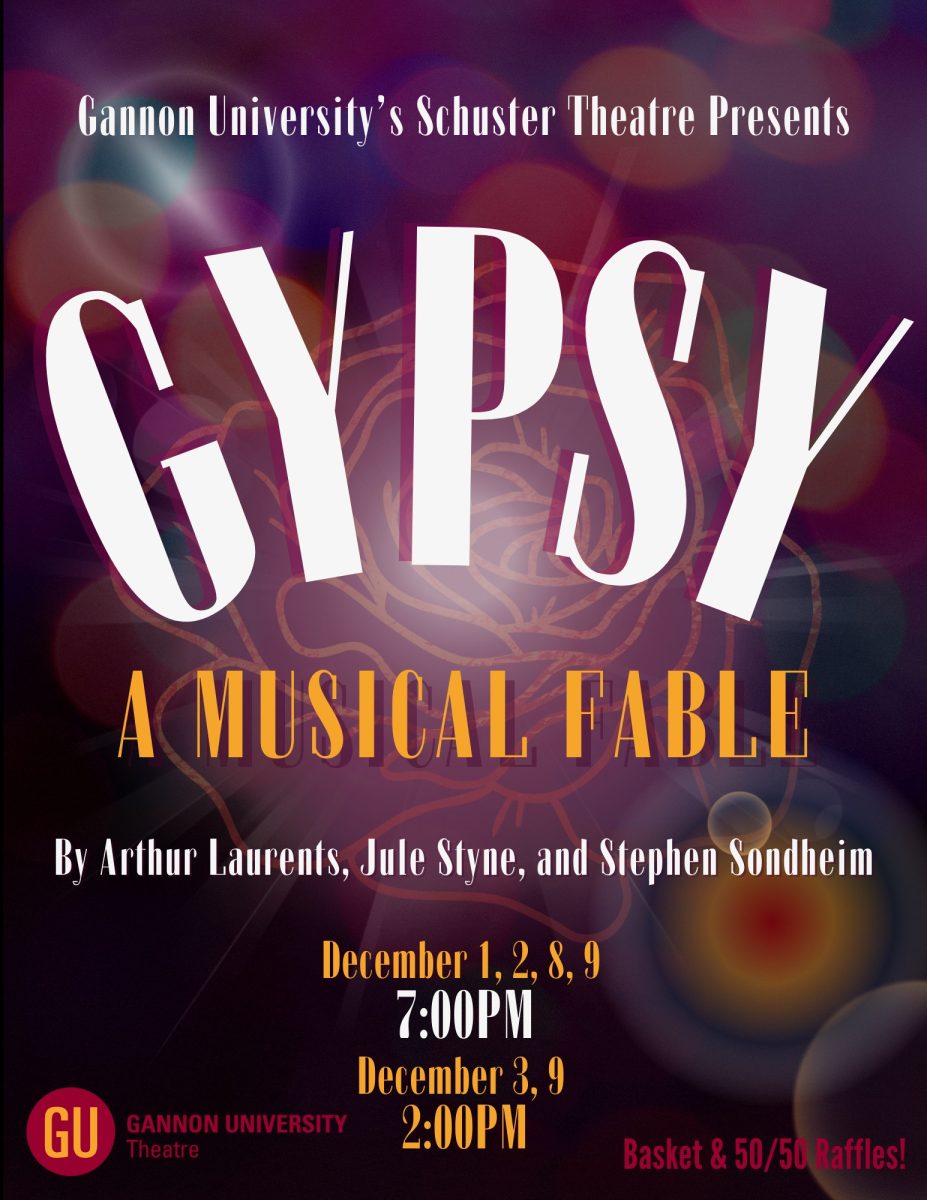Gannon University recently approved the addition of the School of Communication and the Arts to its College of Humanities, Education and Social Sciences (CHESS).
The approval comes after a multi-step process, which resulted in the creation of the school, the designation of a new building to house its components and the movement and revamping of two academic programs under its umbrella, according to AJ Miceli, chairman of the communication arts program.
Miceli said Gannon has had continuously strong local communication and arts programs in the tri-state region. The university has and has had the only four-year theater program in the area, a professional orchestra since the 1970s and the Schuster Art Gallery, all of which solidify the decision of starting a new school.
“Communication and the arts have always been Gannon’s hallmark in the downtown and regional area,” Miceli said. “We are situated right between the Erie Playhouse, the Erie Art Museum and the Erie Philharmonic. So we’re right in Erie’s arts district.”
The School of Communication and the Arts will start with five programs: the communication arts program, the theater program, the theater and communications art program, the journalism communication program and the advertising communication program, the latter two of which were recently moved under its umbrella.
The faculty offices of these programs, along with the Schuster Art Gallery, the TV studio, the audio production studio, the Erie Chamber Orchestra’s band room and the Collins Institute for Archaeological Research are among the components moving to the LCBA building the university bought in 2011 at the corner of Seventh and Peach streets. The move is scheduled to take place before the start of the fall of 2014 term.
Updated equipment will also be added to the building, Miceli said, including three editing bays and a control room that “looks more like 2013.”
Becca Dambach, a junior communication arts major, said the changes to the equipment and the software in the department are necessary.
“I feel like we not only need to learn the Adobe Suite programs, but also design software and editing software that is new and out there,” she said.
The university is allocating about $1.8 million out of capital funds for the renovations to the building and technological equipment for the department, according to Linda Wagner, vice president of finance and administration according to Linda Wagner, vice president of finance and administration.
Additionally, the offices of the media outlets on campus will relocate to the building. The Gannon Knight, 90.5 WERG and the multimedia studio will probably be colocated on the second floor of that building, Miceli said, where room for crossover between the three units exists.
“It makes sense to have all of these parts together to bring collaborations in order to take advantage of the synergies that would be created if everyone were in one place and if the programs could feed off of each other,” Miceli said.
The merging of the programs and facilities allows the department to look at the areas where it is already strong and make them stronger, Miceli said.
“We’ve always been outcome-oriented in our department. We’ve always looked at how a student from our department should look like, what kind of skills and basic knowledge of the industry and liberal arts they should have,” he said. “As part of that, we get to look at this and form the basis of our future and build on this very strong platform.”
Bringing these pieces together Miceli said will also increase enrollment in the communication and arts field, grow the university’s commitment to education in the arts and extend and reinforce Gannon’s brand.
Bill Edmondson, vice president of enrollment, said having the programs located in one building will first help distinguish the school on its own, as faculty will no longer be spread around campus.
He also said the building, which would stand out on a tour, will help with the university’s admission numbers.
In addition to being moved from their respective departments, both the advertising communication and the journalism communication curricula are being revamped as part of the changes taking place.
The programs will focus more on digital production, Miceli said. Several introductory courses are being removed while others to be added are in the process of getting approved through official university channels.
Current students have the opportunity to finish the programs the way they started, but they would also have the option to opt into the new structure as well.
Anne O’Neill, director of the advertising communications program, said it was an excellent opportunity for advertising students to work with students in the communication arts program as part of the new school.
“It will give them exposure to other students that are like-minded and are interested in the at-large communications industry,” O’Neill said.
Prospective students enrolling in the program will graduate with a Bachelor of Arts degree, rather than a bachelor of science degree. O’Neill said students will still take basic business classes, but more of their classes will be focused on areas that they will use day-to-day in the promotions industry.
Due to the lack of time, Miceli said, the faculty could not consult students on the changes to the programs, as the proposal for the change will be presented to the CHESS academic affairs committee on Nov. 1, and will be presented to the board of trustees in February. Fleming said several surveys were sent to alumni during the summer asking them to reflect on their programs.
“The change of the curriculum is not huge. Big changes take longer, and we’re changing baby-steps,” Miceli said. “We are going to tweak it in the right direction and then given the time, and with student and professional input, we’ll see how this thing would really work out.”
Dambach said she felt the new school will enhance her learning experience at Gannon.
“I feel like it’s a great way for separate departments to become united in a bigger way,” she said. “It’s going to get me exposed to other communication fields and make me learn more.”
For Brittnie Knight, a 2012 theatre and communication arts graduate, the creation of the School of Communication and the Arts is long overdue.
“I hope that this shows Gannon University and the community the impact that our small but very influential and intelligent department has on every student that attends Gannon,” Knight said. “The theatre and communications department at Gannon changed my life for the better. I was completely lost in my personal and educational life, and I found a home and career in the communications department.”
Knight said several changes in the curricula need to be considered, including increasing class availability over the course of the programs, making internships and co-ops mandatory and incorporating the organizations around campus in the teaching process more.
“Experience is such a large part of success post-graduation in our fields,” Knight said. “You quite honestly cannot have enough experience. I’ve learned that quickly in grad school.
“Our faculty and students know people that we should be partnering with that could make the educational and networking experience more valuable.”
Miceli, who spearheaded the initiative, said communication and theater faculty members have been thinking about the idea for more than 10 years, but didn’t know how to set it in motion.
The idea was refueled in September during a breakfast meeting Miceli attended with President Keith Taylor, Ph.D., where the latter encouraged faculty, staff and administrators to think about ways to help Gannon distinguish itself in the educational market place.
Miceli said the faculty of the department then started presenting the idea of the new school to “anyone who would listen,” and passing it through appropriate committees and offices, starting with Fleming, who expressed interest in the idea.
“It takes so many things that have been scattered around the university and brings them physically together,” Fleming said. “When you’re spread around, it’s hard for people to know who you are so I thought it was a great idea.”
Fleming said people are working hard on the changes they are introducing to the school and the curricula, while still being very thoughtful about what the programs need.
“I think we are going to see a lot of collaboration within the school itself, but also within the school and the rest of the university as well,” she said.
Fleming said other faculty members are now considering how to better work together on campus and incorporate their classes with possible learning opportunities on campus.
MC Gensheimer, an assistant professor of communication arts, said she was excited about the opportunities the new school will present for students.
She said having the faculty together in one building, instead of five, will create some synergies the department is looking forward to and will make it easier for students and faculty to interact together and help each other in their respective organizations on campus.
Gensheimer said recent approved changes will allow for the addition of new classes, like digital storytelling, which will be a combination of stories, still photography, video and audio produced to convey a message.
HIBA ALMASRI










